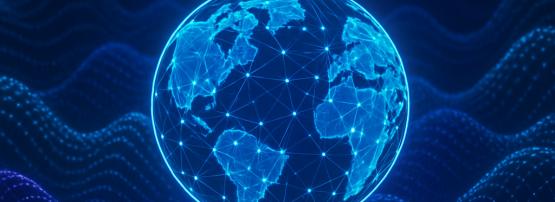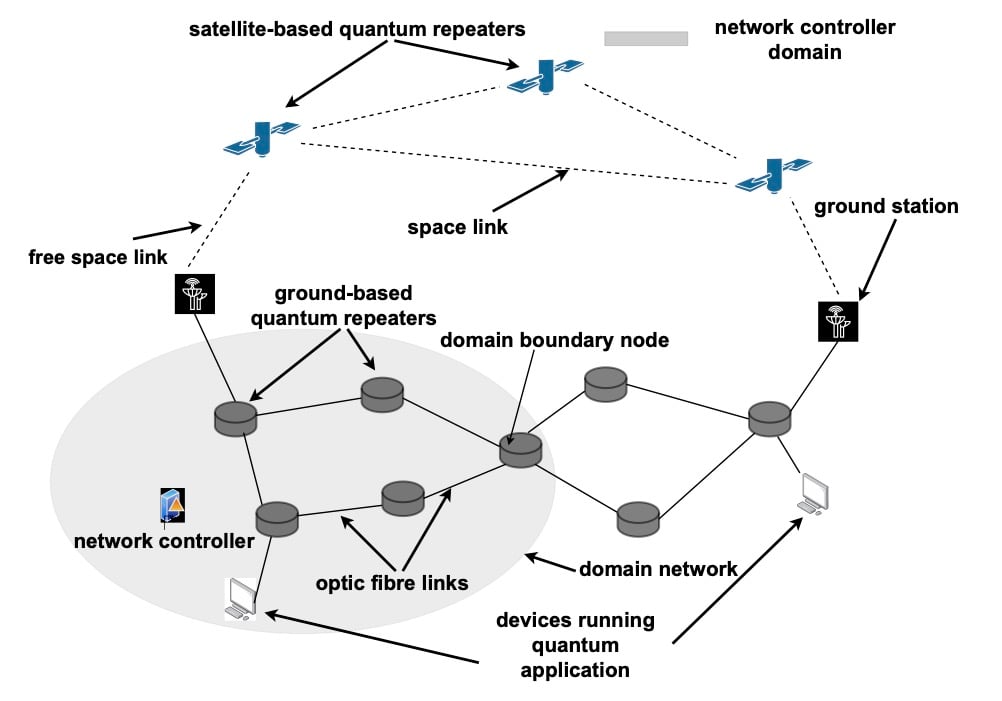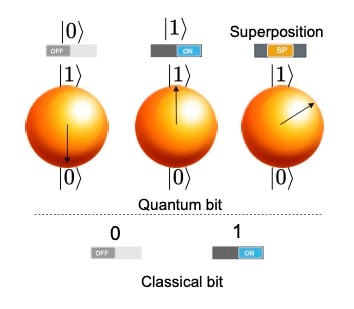
When the Internet first connected computers worldwide, it transformed society, especially the communication among people. Today, we stand at the brink of another revolution shaping itself in the form of quantum Internet. While often mentioned in the same breath as quantum computing, the quantum Internet is a distinct concept. It promises uncompromised security, powerful distributed computing, and scientific applications beyond the reach of classical networks.
This blog post shares highlights from our paper surveying the fundamental concepts of the quantum Internet.
Quantum basics: From bits to qubits
The fundamental workings of any quantum technology are based on the laws of quantum physics, offering quantum mechanical properties like quantum superposition and entanglement. At the heart of quantum technologies lies the qubit, the quantum analogue of the bit. Unlike a classical bit, which is either 0 or 1, a qubit can exist in a superposition of both states (see Figure 1). Even more striking is entanglement, a phenomenon Einstein called “spooky action at a distance,” where two qubits remain correlated no matter how far apart they are.
Entanglement is the fuel of the quantum Internet. By distributing entangled states between distant devices, we can achieve forms of communication that classical networks cannot provide. But quantum mechanics also imposes constraints: We cannot copy an unknown quantum state (the no-cloning theorem), and quantum information is fragile, prone to degradation through decoherence (loss due to environmental noise). These realities shape every design choice for the quantum Internet, diverging from the known classical Internet.
What is the quantum Internet?
The quantum Internet is not simply a faster or more secure version of today’s Internet. Instead, it is a network for sharing entanglement. Once two devices share an entangled state, they can use it for secure key exchange, to teleport quantum information (moving a quantum state across distance without physically sending the particle), or to collaborate on distributed quantum tasks.

In practice, a future quantum Internet will coexist with the classical Internet (see Figure 2). Classical channels will carry control information, while quantum channels distribute entanglement. Together, they enable new protocols that go beyond anything achievable with the current established Internet infrastructure.
Why does it matter?
For networking professionals, the quantum Internet is not an abstract research idea but a developing technology with clear applications:
Security and privacy: Quantum Key Distribution (QKD) enables two parties to generate secret keys with security guaranteed based on the laws of quantum physics, not just algorithms. Other applications include blind quantum computing (outsourcing computations without revealing data) and e-voting.
Computing power: Distributed quantum computing links multiple quantum processors via entanglement. This helps overcome the current limits on qubit numbers and unlocks exponential speed-ups over classical distributed systems.
Specialized applications: Quantum sensing networks promise unprecedented precision in measurements. Quantum-enhanced time synchronization and long-baseline telescopes could transform navigation, astronomy, and earth observation.
Where are we today?
Progress toward the quantum Internet is unfolding in stages. Each subsequent stage enables functionalities over the previous stage of the network.
- Basic QKD networks, already deployed in cities and through satellites.
- Entanglement distribution, demonstrated in labs.
- Networks with quantum memory, enabling purification. Quantum memories are special devices that can store qubits without destroying their fragile state. They act like a waiting room for quantum information, making it possible to coordinate entanglement distribution across different links. Once entanglement is stored, purification protocols can be applied: Multiple imperfect entangled pairs are combined and processed to produce a smaller number of higher-fidelity pairs. This is essential to overcome the noise and loss that plague long-distance quantum links.
- Limited fault-tolerant networks with logical qubits. As networks grow, errors from noise and decoherence become unavoidable. Here, Quantum Error Correction (QEC) comes into play. Instead of storing information in a single fragile qubit, data is encoded across many physical qubits to form a logical qubit that is much more robust. Networks based on logical qubits can tolerate faults and sustain long-distance entanglement distribution, paving the way for reliable quantum communication and scalable distributed computing.
- A full-fledged quantum Internet supporting distributed quantum computing.
Right now, we are between stages one and two. Early QKD networks are operational, while experiments continue on entanglement distribution and quantum repeaters.
The challenges ahead
Building a quantum Internet requires solving problems that have no classical equivalent.
We’ll need quantum repeaters to extend entanglement over long distances. Fragile qubits will need to be stored in quantum memory. New forms of error correction will be required to fight noise and decoherence. New standards will need to be created to ensure interoperability across technologies and geographies.
These challenges are real, but so is the momentum. Governments, research labs, and industry players invest heavily in prototypes and testbeds.
Looking forward
The quantum Internet will not replace today’s Internet but will expand its capabilities in ways we are only beginning to imagine. For network operators, it is worth paying attention now: Just as the early Internet grew from academic networks into a global infrastructure, the quantum Internet may one day underpin critical services.
In short, we are watching the birth of a new kind of network, one that harnesses the laws of quantum mechanics to enable secure, collaborative, and powerful applications. The journey is just beginning, and its impact could be as profound as the transition from telegraphs to the Internet itself.
Read our paper for a more complete, systematic introduction to the quantum Internet, including its importance, core components, operational mechanisms, anticipated timeline for viability, key contributors, major challenges, and future directions.
Vinay Kumar is a doctoral researcher in the Department of Information Engineering at the University of Pisa, jointly affiliated with IIT‑CNR, Pisa. He works in quantum information science with a focus on quantum networking, particularly the theory and design of routing and optimization protocols.
The views expressed by the authors of this blog are their own and do not necessarily reflect the views of APNIC. Please note a Code of Conduct applies to this blog.


The quantum Internet will facilitate a quantum global economy. The ‘Store-Now-Decrypt-Later’ is a new kind of cyber risk where harvested data will be decrypted later in the Quantum future when the technology is out on the market. Transitioning ICT systems to Post-Quantum Cryptography should be compulsory for every country who are aware of quantum computing threats. For developing countries like Papua New Guinea, migration into Post-Quantum Cryptography was endorsed by Prime Minister James Marape and his cabinet but we lack cyber security professionals to implement NEC Decision dated 17th February 2025. APNIC should offer fellowships to facilitate technical trainings to give hands-on experience to cyber security professionals in the Pacific Islands Countries to transition systems into quantum safe cyber space or Post-Quantum Cryptography akin to US Department of State funded programs like Post-Quantum Cryptography in the Indo-Pacific Program’ which is facilitated by Monash University Australia’s Information Technology Department in partnership with Oceania Cyber Security Center.